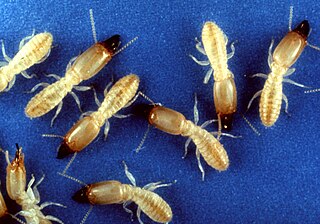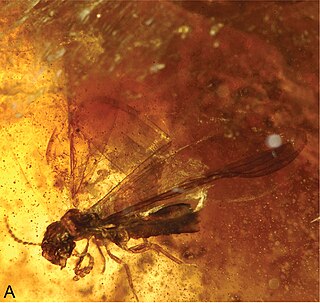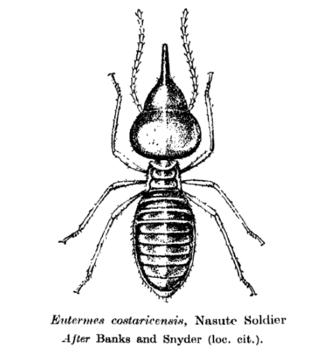
Termites are a group of detritophagous eusocial insects which consume a wide variety of decaying plant material, generally in the form of wood, leaf litter, and soil humus. They are distinguished by their moniliform antennae and the soft-bodied and typically unpigmented worker caste for which they have been commonly termed "white ants"; however, they are not ants, to which they are distantly related. About 2,972 extant species are currently described, 2,105 of which are members of the family Termitidae.
Autothysis or suicidal altruism is the process where an animal destroys itself via an internal rupturing or explosion of an organ which ruptures the skin. The term was proposed by Ulrich Maschwitz and Eleonore Maschwitz in 1974 to describe the defensive mechanism of Colobopsis saundersi, a species of ant. It is caused by a contraction of muscles around a large gland that leads to the breaking of the gland wall. Some termites release a sticky secretion by rupturing a gland near the skin of their neck, producing a tar effect in defense against ants.

Reticulitermes flavipes, the eastern subterranean termite, is the most common termite found in North America. These termites are the most economically important wood destroying insects in the United States and are classified as pests. They feed on cellulose material such as the structural wood in buildings, wooden fixtures, paper, books, and cotton. A mature colony can range from 20,000 workers to as high as 5 million workers and the primary queen of the colony lays 5,000 to 10,000 eggs per year to add to this total.

Amitermitinae is a disputed subfamily of "higher termites" now often merged with the subfamily Termitinae and is considered by ITIS as a synonym; it had previously been placed in the family Rhinotermitidae.

Termitidae is the largest family of termites consisting of 2,105 described species of which are commonly known as the higher termites. They are evolutionarily the most specialised termite group, with their highly compartmentalized hindgut lacking the flagellated protozoans common to "lower termites", which are instead replaced by bacteria. Whereas lower termites are restricted mostly to woody tissue, higher termites have diverse diets consisting of wood, grass, leaf litter, fungi, lichen, faeces, humus and soil. Around 60% of species rely on soil-feeding alone.

Kalotermitidae is a family of termites, commonly known as drywood termites. Kalotermitidae includes 21 genera and 419 species. The family has a cosmopolitan circumtropical distribution, and is found in functionally arid environments.

Globitermes sulphureus is a species of termite that is very common in central and southern Vietnam and also present in other areas of South East Asia, including Cambodia, Thailand, and Peninsular Malaysia. They live in nests made of earth that can be up to 1.5 m tall and can contain tens of thousands of individuals. Between five and 10 per cent of the population are soldier termites which can be recognised by their yellow abdomen and two large, curved mandibles. The termites use autothysis as a defense mechanism.

Coptotermes gestroi, commonly known as the Asian subterranean termite is a small species of termite that lives underground. Both this species and the Formosan subterranean termite are destructive pests native to Asia, but have spread to other parts of the world including the United States. In Asia, this species is known as the Philippine milk termite.

The fontanellar gun is a termite defense mechanism in the form of a horn-like frontal projection (nasus) on the head of the soldier caste which is capable of expelling chemical weaponry at a distance, a trait exclusive to the subfamily Nasutitermitinae. It is primarily used to ward off predators such as ants.

Reticulitermes is a termite genus in the family Rhinotermitidae. They are found in most temperate regions on Earth including much of Asia and the Middle East, Western Europe, and all of North America.

Amitermes is a genus of termites in the family Termitidae. Species are found in a range of habitats including deserts and rainforests. Characteristics of Amitermes soldiers include a bulbous head, sickle-shaped mandibles with a single tooth on their inner margins and cephalic glands on the front of their heads.

Nasutitermes triodiae, also known as the cathedral termite, is a grass-eating species of Nasutitermitinae termite that can be found in Northern Territory, Australia. It is also sometimes referred to as the spinifex termite, since it is found in the spinifex grasslands. Very little research has been done on the underground nature of this species.

The Nasutitermitinae is a cosmopolitan subfamily of higher termites that includes more than 80 genera. They are most recognisable by the more highly derived soldier caste which exhibits vestigial mandibles and a protruding fontanellar process on the head from which they can "shoot" chemical weaponry. True workers of certain genera within this subfamily also exhibit a visible epicranial y suture, most notably found within the members of Nasutitermes. Notable genera include the notorious wood-eating Nasutitermes, and the conspicuous Hospitalitermes and Constrictotermes, both genera characterized by their behavior of forming large open-air foraging trails.

Macrotermes carbonarius, also known as Kongkiak in Malay, is a large black species of fungus-growing termite in the genus Macrotermes. It is one of the most conspicuous species of Macrotermes found in the Indomalayan tropics, forming large foraging trails in the open that can extend several metres in distance. M. carbonarius is a highly aggressive species with the soldiers possessing large curving mandibles that easily break skin. It is found in Cambodia, Malaysia, Myanmar, Singapore, Thailand and Vietnam.

Hospitalitermes is an Asian–Papuan genus of lichen eating termite in the subfamily Nasutitermitinae. There are 37 species currently listed, of which most are recognized for their extensive surface foraging columns. Due to their conspicuous foraging activities they are commonly known as processionary or marching termites. They often inhabit cavities inside of living trees excavated by other species of termite.

Syntermes is a genus of large Neotropical higher termites within the subfamily Syntermitinae. The genus is found only in South America where members are distributed widely throughout the continent, being found from the tropical rainforests of Colombia to the savannas of Brazil and Northern Argentina.

Constrictotermes is a genus of Neotropical higher termites within the subfamily Nasutitermitinae. They form large open-air foraging columns from which they travel to and from their sources of food, similar to the Indomalayan species of processionary termites. Species of this genus commonly build epigeal or arboreal nests and feed on a variety of lichens, rotted woods and mosses.

Constrictotermes cyphergaster is a Neotropical species of open-air foraging nasute termite within the genus Constrictotermes. This species is distributed widely throughout South America and lives within xeric habitats such as the savannas found in Paraguay, Bolivia, Central Brazil, and Northern Argentina. C. cyphergaster primarily builds arboreal and transient epigeic nests and mainly consumes dead woods at varying stages of decomposition.
Rhynchotermes is a genus of Neotropical higher termites within the subfamily Syntermitinae, represented by 8 known species. Species of this genus are known for their soldiers which have highly developed sickle-shaped mandibles and a pronounced frontal tube superficially analogous to the fontanellar guns of true nasute termites. Most species forage above the surface in the open where they primarily feed on forest leaf litter. Nests are subterranean or are shallow and epigeic.

Cubitermitinae is an Afrotropical subfamily of higher termites with 28 known genera and 147 species. The nests of most taxa are either subterranean or found within the mounds of other termite species. The most well known genus of this subfamily is Cubitermes, which commonly build epigeal nests with one or more caps used to shield the nest against rainfall, giving them a characteristic mushroom shape. Most members of this subfamily are soil-feeders.















